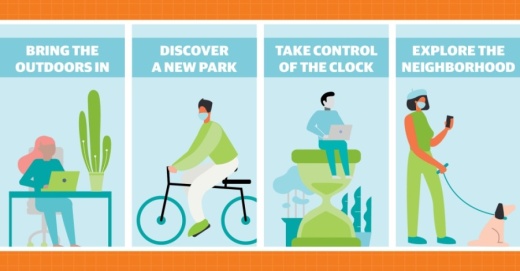Bring the outdoors in
With the option of remote work allowing more people to stay at home, potentially even beyond the pandemic, adding touches of nature can improve the immediate environment and offer health benefits.
“Nothing beats houseplants to make your home cozy,” said Joshua Kornegay, the owner of Joshua’s Native Plants in the Heights for almost 30 years. “It not only lowers your blood pressure, it cleanses the air; it releases oxygen. Your house will smell fresher, and you’ll breathe easier.”
Snake plants are a popular indoor option that do well in any kind of light and do not need much watering or special soils, he said, with the added bonus of being the most prolific plants for producing oxygen. There is also the fiddle leaf fig, often a fixture in office buildings, that is known for thriving indoors.
Once the home starts turning green, look to the front yard and backyard, too, Kornegay said.
“There’s nothing better for the soul than putting your hands in the earth,” he said.
Discover a new park
While Houston’s Inner Loop offers several iconic parks such as Hermann Park and Memorial Park, these have also become overcrowded on weekends with nice weather despite social distancing orders.
“We’ve known how essential parks are to the health of communities ... but they are even more crucial as people are trying to cope and stay healthy. It’s heartening to see,” said Beth White, president and CEO of the Houston Parks Board. That said, White encourages all parkgoers to practice social distancing and to explore Houston’s sprawling parks and trails system with over 360 parks citywide.
“We have room for people to spread out. We have greenways, trails, bike lanes, sidewalks, parks,” she said.
One feature to explore is the city’s Bayou Greenways, which are nearing completion of an eight-year, $220 million investment that put 1.5 million Houstonians within 1.5 miles of a trail and greenway. Access a map of the Bayou Greenways at www.houstonparksboard.org.
Take control of the clock
Managing the use of time and being realistic with expectations are mental health game-changers that, if people can master during the coronavirus, will pay off in the long run, said Ceci Hudson Torn, licensed professional counselor and co-founder of Ethos Behavioral Health Group, which manages the Prism Center in Bellaire.
“Pre-pandemic, many of the things that provided us structure was changing location—going to the office, going to a restaurant. Now that structure needs to be internal,” she said.
Calendar apps can be used to block hours of the day dedicated to work, home and social needs. For children, a whiteboard with a daily or weekly schedule can help provide a sense of routine and prevent chaos.
When developing a system, keep expectations in check to prevent a pileup of anxiety and the feeling of underperforming, she said.
“Some of us, we’re managing work at home, managing the household 24/7 and meal prepping, and managing full-time parenting, and home schooling all at once,” Torn said. “Just have a ton of self-compassion and flexibility with ourselves. No one person can do all these things well.”
Explore the neighborhood
Not only does going outside offer the opportunity for exercise, it could also bolster social and civic health.
“Walking around our neighborhood is a true gift, connecting us to community and a sense of the outdoors, which we might have taken for granted in the past,” said Heather Houston, the executive director for Scenic Houston, which helps government and civic groups improve their streetscapes. “If you’re lucky, you’re experiencing an enjoyable walk on a safe, landscaped, nice sidewalk without obstructions. ... But not everyone is so lucky.”
With more people out and about, they are noticing areas that may not be friendly for walking and biking, she said, which hopefully means more neighborhood advocates will start asking for improvements. The difference between a community with good walkable areas and those without often comes down to being well organized and advocating for funding, she said.
“I hope there’s a silver lining in all this, that we all grow to appreciate our neighborhood community,” Houston said. “Individuals, when they get together, can make a huge difference.”





